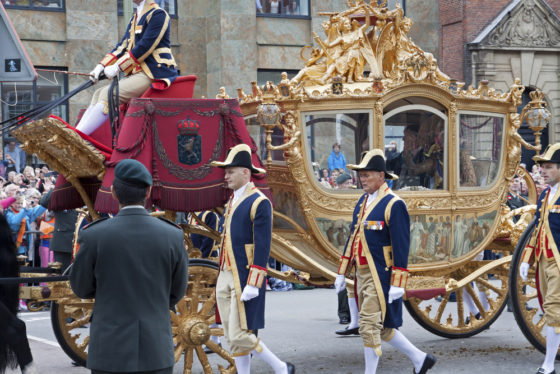Gold in Golden Coach came from Suriname, experts conclude


The gold lining the Gouden Koets, the gilded carriage used until recently to transport the king and queen on ceremonial occasions such as Prinsjesdag, almost certainly came from the former colony of Suriname, experts have concluded.
Analysis of a tiny piece of gold taken from the carriage during its recent restoration indicated that the metal was most likely to have been mined in the former Dutch colony during the 19th century.
Annemarie de Wildt, curator at Amsterdam Museum, already suspected that the gold came from either Suriname or South Africa, but the documents that would establish its provenance have been lost.
Instead the museum worked with Gareth Davies, professor of petrology – the study of the composition of rocks – at the Vrije Universiteit (VU) in Amsterdam, to compare the gold from the coach with particles from South Africa, as well as specialists from the Netherlands Institute for Conservation, Art and Science (Nicas) and Naturalis Biodiversity Centre.
‘The makers and initiators of the Golden Coach prided themselves on the fact that the gift to the new monarch, Wilhelmina, was meant to represent the entire Kingdom of the Netherlands at the time,’ said de Wildt.
‘Suriname, which was then part of the Kingdom of the Netherlands, did not seem to be represented. That raised questions for myself and many others.
‘South Africa was a major exporter of gold around 1900, and the region had strong ties with the Netherlands, but in Suriname people have said from generation to generation that the gold comes from there.’
Golden Coach on display in museum
Comparing isotopes
Davies explained that his studies had ruled out South Africa as the source of the gold, leaving Suriname as the only credible candidate.
‘To compare gold, we look at the lead isotopes formed by the radioactive decay of the elements uranium and thorium. These vary by region,’ he said.
‘A clean sample is needed for such a comparison. But the gold of the Golden Coach contained numerous lead particles that came from the air pollution to which the coach has been exposed over the years, such as exhaust fumes from gasoline.
‘It was like plucking a single grain of sand out of a pool filled with sand, a huge job that took more than four months.
‘After careful analysis, we can say with certainty that the gold of the Golden Coach did not come from South Africa. From a historical perspective, South Africa or Suriname are seen as the only probable options.’
Vehicle for controversy
The coach was made in 1898 as a gift for Queen Wilhelmina at her coronation with materials including Javanese teak wood, ivory from Sumatra and leather from Brabant.
It was intended to represent all the corners of the Dutch empire, but has become controversial in recent years because of a side panel that depicts black slaves bowing and offering gifts to a white woman.
It was taken out of circulation in 2016 for a five-year restoration, after which it went on display in the Amsterdam Museum for eight months until February this year. There is strong speculation that it will not return to active service.
Suriname became an independent republic in 1975 after three centuries of Dutch colonial rule. On Monday Mark Rutte arrived in Paramaribo for the first visit by a Dutch prime minister since 2008, accompanied by international trade minister Liesje Schreinemacher.
Thank you for donating to DutchNews.nl.
We could not provide the Dutch News service, and keep it free of charge, without the generous support of our readers. Your donations allow us to report on issues you tell us matter, and provide you with a summary of the most important Dutch news each day.
Make a donation